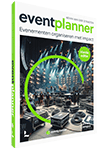A good invitation must be eye-catching, intriguing and exciting. Try to persuade your target group with a combination of rational and emotional arguments. Why should they come to your event? How can you persuade them to give up some of their precious free time?
Some guests will only take part if there are good networking possibilities; others are partial to expert presentations by leading professionals in their field. You should also try to play on their emotions, but this will only work if you do it in the right manner. It has been mentioned before, but it bears repeating: you must know how your target group thinks and feels! Invitations differ according to the function of the people you are trying to attract. An invitation for an executive will not be the same as an invitation for a sales rep. Remember to adjust the form, style, tone, language and colour to suit your target group. tip A A short and clear message always works best. Avoid too much text. Emphasise the date and venue as eye catchers.
While you obviously need to stress the importance of the event itself, also explain why the presence of the invitee is so crucial to its success. Your guests need to feel important. But don’t be too blatant with your flattery. Subtle hints are better and make your event more exclusive. Your creativity and originality should already start with the envelope. An elegant invitation does not belong in a boring impersonal envelope. Are you trying to attract people who you know have a busy professional life? Send a warm-up letter or a ‘teaser’. If their curiosity is aroused, this allows them to keep the date free in their diary. Or you may prefer to send a ‘save-the-date’ message by e-mail. Always use the same style and layout. It is important that all your communications can be directly and visually linked to your event.
The amount of information contained in your invitation will vary from event to event. However, some information is so essential that it always needs to be included:
- Who? Who is organising the event? Who is receiving an invitation? What kind of public will be present (trade, press, etc.)?
- What? What can your guests expect? What is on the programme? Unless, of course, this needs to be kept as a surprise. Even so, always try to arouse the invitee’s curiosity.
- Where? Where is the event taking place? How do you get there and where can you park? Include a map and a route plan, which takes account of people approaching from different directions.
- When? What is the date of your event? At what time are the guests expected to arrive? Is there an official closing time?
- Why? What is the purpose of the event?
- Response How can you register your attendance? By what date do you have to do this? To whom should the invitees address any questions they might have (telephone number, e-mail address, contact person)?
Is there something out of the ordinary about your event? Do you expect something extra from your guests? Remember to mention it on the invitation.
- Are partners and/or children invited (or not)?
- Is a particular type of clothing desired? What is the dress code?
- Is the invitation a personal one, or can it be passed on to a colleague or (business) partner?
- Admission charges, conditions, etc.
Is it necessary for your invitees to let you know whether they are coming or not? If so, make this clear on the invitation. Even though it is essentially a matter of politeness to reply to an invitation, not everyone will do it. You can encourage the type of response you want by using one of a standard series of abbreviations. You may need to bear in mind that not everyone will be familiar with the meaning of these abbreviations, so sometimes you will have to spell it out more literally, depending on the target group concerned.
- RSVP (Répondez, s’il vous plaît). This requests a reply from the invitee, to confirm whether they are coming or not.
- Regrets only. This is used when only negative replies are necessary.
- RFSVP (Response favorable s’il vous plaît). This is used when only positive replies are necessary.
Dutch
Een goede uitnodiging moet opvallen, verleiden, knallen, … Overtuig je doelgroep met rationele en emotionele argumenten. Waarom zouden zij naar het evenement komen? Wie kun je met wat overtuigen?
Sommige gasten komen alleen als er mogelijkheden zijn om te netwerken, anderen zijn weer erg gevoelig voor presentaties van autoriteiten. Speel ook in op emoties. Dit kan en mag als je het op de juiste manier doet. Ken je doelgroep! Wellicht ziet de uitnodiging voor zaakvoerders er anders uit dan die voor verkopers. Let er op dat vorm, stijl, toon, taal en kleur passen bij je doelgroep.
TIP: Een korte en duidelijke boodschap werkt altijd! Dus niet te veel tekst. Benadruk de datum en de locatie als eyecatchers.
Leg niet alleen de nadruk op het evenement zelf. Zeg je genodigden waarom zij onmisbaar zijn voor je evenement. Je gasten moeten zich belangrijk voelen. Dit hoef je niet expliciet te doen. Geef subtiele hints en maak je event exclusief.
Creativiteit en originaliteit beginnen al bij de enveloppe. Een prachtige uitnodiging hoort niet thuis in een saaie, onpersoonlijke envelop. Ben je uit op enkele genodigden met een erg drukke agenda? Stuur een vooraankondiging of een teaser. Zo kunnen zij alvast een
gaatje vrijhouden voor je evenement. Je kunt ervoor kiezen om de save-the-dateboodschap te versturen per mail. Gebruik wel steeds dezelfde stijl en opmaak. Alle communicatie-uitingen moeten meteen visueel gelinkt kunnen worden aan het evenement!
TIP: Voor sommige evenementen kan het helpen de gastenlijst op de website van je evenement te publiceren om een hogere respons te krijgen. Bepaalde gasten zullen immers alleen maar komen wanneer ook andere belangrijke relaties of hun concurrenten aanwezig zijn.
Onmisbare informatie
De hoeveelheid informatie op je uitnodiging hangt af van je evenement. Sommige informatie is echter zo essentieel dat die niet mag ontbreken:
- Wie? Wie organiseert het evenement? Wie ontvangt een uitnodiging? Welk publiek mag je verwachten (business, pers …)?
- Wat? Wat mogen de gasten verwachten? Wat staat er op het programma? Tenzij dit nog een verrassing moet blijven natuurlijk … Probeer de nieuwsgierigheid in ieder geval te prikkelen.
- Waar? Op welke locatie worden de gasten verwacht? Hoe kom je er en waar kun je parkeren? Voeg een plannetje en een duidelijke routebeschrijving vanuit verschillend richtingen toe.
- Wanneer? Op welke datum vindt het evenement plaats? Wanneer worden de gasten verwacht? Is er een sluitingsuur voorzien?
- Waarom? Wat is de aanleiding van het evenement?
- Respons Hoe schrijf je jezelf in? Wat is de laatste inschrijvingsdatum? Waar kunnen genodigden terecht met vragen (telefoonnummer, e-mailadres, contactpersoon)?
Gebeurt er iets afwijkends? Verwacht je iets extra’s van je gasten? Vergeet dat dan niet te vermelden op de uitnodiging.
- Worden partner en/of kinderen wel/niet uitgenodigd?
- Is een bepaald soort kledij of stijl gewenst? Wat is de dresscode?
- Ben je persoonlijk uitgenodigd of mag je de uitnodiging doorgeven aan een collega of (zaken)partner?
- Inschrijvingskosten, voorwaarden …
Wil je dat je genodigden een seintje geven of ze al dan niet aanwezig zullen zijn? Vermeld dat dan duidelijk op de uitnodiging. Ook al is het een beleefdheidsvorm te reageren op een invitatie, niet iedereen zal dat doen. Je kunt je voorkeur aangeven door middel van onderstaande afkortingen, maar houd er rekening mee dat sommige doelgroepen er misschien niet vertrouwd mee zijn. In dat geval schrijf je je verzoek best voluit.
- RSVP (Répondez, s’il vous plaît). Hiermee verzoek je je gasten te reageren op de uitnodiging, om aan te geven dat ze wel/niet aanwezig zullen zijn. Je kunt ook de afkorting AAUB (Antwoord alstublieft) gebruiken als synoniem voor RSVP.
- Regrets only. Dit plaats je op de uitnodiging wanneer je van je genodigden een reactie verwacht wanneer zij niet ingaan op de invitatie.
- RFSVP (Response favorable s’il vous plaît). Deze afkorting gebruik je wanneer je, alleen wanneer genodigden jouw uitnodiging aanvaarden, om een bevestiging vraagt. Als alternatief kun je ook VGA (Verzoek gunstig antwoord) gebruiken.
More about this topic and lots of other tips about organising events can be found in the book EVENTS.
Order now






Goed dat hier de onmisbare vragen worden besproken. Ben zelf ook van mening dat deze vragen op een goede manier verpakt moeten worden, zodat het de aandacht van de genodigde trekt. Daarnaast vind ik het ook altijd goed om het thema zo goed mogelijk terug te laten komen in de uitnodiging.